| |
Highlights
- Rats who gave up when confronted with stressful situations (passive copers) developed depressive-like symptoms, increased inflammation and a more pronounced stress response compared to rats who stood their ground (active copers).
- Blocking inflammation decreased depressive-like behaviors in passive coping rats.
- People who adopt active coping styles in stressful situations tend to be healthier than those who adopt passive coping styles.
How social are you? Do you prefer to spend time alone or in the company of friends or family? Though there is a wide range of individual preferences for social interaction, humans are basically social animals. This means that we generally seek out and enjoy the company of others, and each of us needs human relationships to be happy and healthy.
Social relationships can bring us incredible joy, but human interaction can also be quite stressful. The stress we experience as a result of our social environment is known as
social stress.
You are perhaps familiar with some everyday social stressors like the nervousness before giving a class presentation or feeling awkward at a school dance. More severe examples of social stress include the loss of a loved one or
bullying.
“Humans are basically social animals. This means that we generally seek out and enjoy the company of others, and each of us needs human relationships to be happy and healthy.”
While some social stress is an inevitable part of our lives as social beings, repeated or chronic social stress can have negative long-lasting consequences. There is a large body of evidence connecting social stress with the development of conditions such as
depression
and
anxiety disorders
in humans, but how this happens remains unclear. New research by Dr. Susan Wood and a team of colleagues at the University of South Carolina School of Medicine in Columbia, SC, helps explain the link between social stress and
mental illness,
with the potential to change our understanding of both.
Humans and Beyond
Humans are not the only animals that experience social stress and potentially negative consequences as a result. It turns out that rats do, too. “We’ve observed that rats who undergo social stress often develop depressive-like symptoms,” explains Dr. Wood. This has been shown repeatedly using a rat model of social stress known as the resident-intruder model.
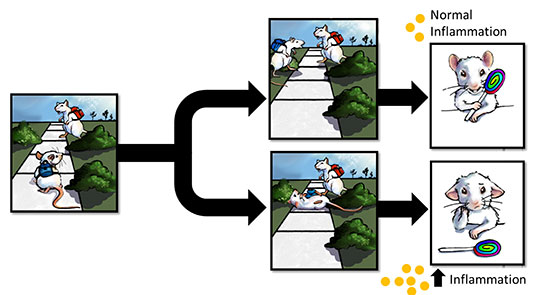
The resident-intruder model of social stress (Panel 1). Differences in intruder rat behavior are shown in Panel 2. Some intruders stood their ground while others rolled over to submit. Panel 3 indicates rats who fought back had normal inflammation while rats who gave up readily had increased levels of inflammation and anhedonia (a depressive-like behavior).
(Picture drawn by Victoria Macht, graduate student in Pharmacology, Physiology, and Neuroscience at the University of South Carolina School of Medicine in Columbia, SC)
In this model, researchers introduce two male rats to each other. The rats are two different rat strains: one strain is larger and more territorial than the other. Rats, like humans, are naturally social creatures. However, rats tend to live in a social hierarchy, where the strongest male is considered to be the leader, or alpha. As such, male rats are very territorial. In this resident-intruder study rats are housed in separate cages except for thirty minutes per day for five days. During this thirty minute period, the smaller rat—the intruder—is taken from his cage and placed into the cage with the larger rat—the resident. What do you think happens?
Neither rat is particularly happy about this arrangement. Eventually the smaller intruder rat is forced to submit to the larger resident rat. You have probably observed submission behavior in dogs, lying on their backs to expose their bellies. This is a very vulnerable position for most animals. Rats exhibit the same submissive behavior as dogs, with the intruder rat rolling onto his back to expose his belly. This forced submission is a very stressful situation for the intruder rat.
The resident-intruder model of social stress has been around for several decades. Dr. Wood used this model during her post-doctoral research. Observing the behavior of rats over several years, Dr. Wood began to notice individual differences in intruder rat behavior. Although the intruder rats did all eventually submit to the larger resident rats, they did not all behave the same way. “Some of the intruders immediately rolled over to submit,” explains Dr. Wood. “But some of them stood their ground for a while.” The two groups of rats are distinguished by their coping style when confronted with social stress. The rats who fought back were characterized as active coping rats and the rats who gave up readily each day were characterized as exhibiting passive coping behaviors.
The differences in behavior had very specific effects on the consequences of social stress exposure. At the end of the five repeated thirty-minute resident encounters, only passive coping rats develop depressive-like symptoms. “We are not saying that the rats become depressed,” Dr. Wood emphasizes. “We don’t know whether rats can become depressed in the same way that humans do.” But there is a dramatic shift in behavior. Unstressed rats will readily drink sugar water. However, rats that underwent social stress and exhibited a passive coping response drink significantly less of the sugar water after the resident encounters, indicating a depressive-like state. Interestingly, the active coping rats did not show the same decrease in sucrose preference. “It’s really a remarkable change,” comments Dr. Wood.
Dr. Wood wondered whether the behavioral differences she observed in the rats might lead to lasting physiological differences. To find out, she started adjusting the model and taking measurements. Dr. Wood focused on markers of stress and inflammation that would result from stress. These included the
hormones
of the pathways responsible for the
stress response
such as
corticotropin releasing factor,
adrenocorticotrophic hormone,
corticosterone,
and
norepinephrine.
In addition, Dr. Wood tested a variety of proteins including
interleukin-1 beta
(IL-1β),
tumor necrosis factor alpha
(TNFα) and
granulocyte macrophage colony stimulating factor
(GM-CSF), which are involved in inflammation and the immune response in the brain and other organs. “For all of the parameters we studied, there was a clear difference between the rats who fought back and the rats who didn’t,” explains Dr. Wood.
Dr. Wood demonstrated that both active and passive coping rats had elevated levels of stress hormones immediately following the stressful situation. In the active coping rats, these levels eventually decreased over time, even as the rats continued to be exposed to the stressful situation for several more days. The passive coping rats, on the other hand, maintained heightened levels of stress hormones well beyond the end of the stressful experience. “It was remarkable,” recalls Dr. Wood. “The passive coping rats exhibited a significantly delayed response to return to pre-stress levels.” In all of the behavioral and chemical studies Dr. Wood conducted comparing the active and passive coping rats, the initial coping strategy seemed to make all the difference.
“For all of the parameters we studied, there was a clear difference between the rats who fought back and the rats who didn’t.”
Dr. Wood’s findings parallel what mental health clinicians and researchers have observed in humans. “People who adopt active coping styles in the face of stress tend to be healthier in the long run than those who adopt passive coping styles,” explains Dr. Wood. “This is why our work in rats is so important.”
Protection from Stress
Recently, Julie Finnell, a doctoral student in Dr. Wood’s laboratory, used the resident-intruder model to investigate the link between inflammation and depression. Many researchers have identified a link between increased inflammation and depressive disorders in people. The same has been shown to be true in animals exhibiting depressive-like behaviors.
Since the passive coping rats in the resident-intruder model exhibited depressive-like symptoms and inflammation, Julie hypothesized that blocking inflammation might protect against the development of depressive behaviors. One common symptom of depression in both humans and animals is
anhedonia,
the decrease in ability to experience pleasure. In people, this means that someone who used to love running or cooking or watching movies just doesn’t enjoy those activities anymore. In rats, anhedonia can be determined by a loss of interest in sugar water.
Julie quantified the depressive-like behaviors in both active and passive copers by measuring the amount of sugar water they drank compared to regular water. When given the choice, 95% of the liquid that control rats (that were not exposed to stress) drank was from the sucrose bottle. Passive coping rats, on the other hand, only drank the sugar water about 75% of the time, indicating a clear loss of interest in this sweet solution.
To determine if blocking inflammation might protect against the development of depressive behaviors, Julie treated the rats with the natural anti-inflammatory agent
resveratrol,
known as RSV for short. RSV is found in dark, bluish-red fruits such as grapes, blueberries, and pomegranates. Although RSV can be ingested with food, for these experiments Julie used an injectable version of the compound to ensure each animal was treated with the same dose. She then measured the levels of proteins that are markers of inflammation.
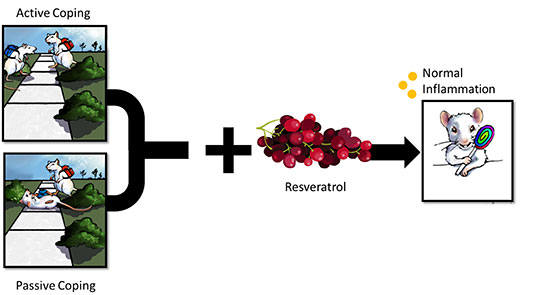
Treating rats with resveratrol just prior to the resident-intruder stress blocked increases in inflammation and blocked the development of anhedonia even in passive coping susceptible rats.
(Picture drawn by Victoria Macht, graduate student in Pharmacology, Physiology, and Neuroscience at the University of South Carolina School of Medicine in Columbia, SC)
The intruder animals were given an injection of RSV for a total of twelve days: seven days before testing and during the five days of resident exposure. The results were positive. “We found that the passive copers who were given RSV seven days prior to testing drank a significantly greater proportion of sugar-water than the passive copers who did not receive RSV.” She also found that the increased levels of inflammatory proteins (ie., IL-1β, TNFα, GM-CSF) that occurred in the brains of passive coping rats were blocked by treatment with RSV.
“There are many ways to reduce inflammation without medications.”
This finding is important for several reasons. First, there are so many synthetic anti-inflammatory compounds produced by drug companies, but Julie Finnell and Dr. Wood achieved these results with a natural compound that can be found in readily available food sources. Second, these results contribute to a larger body of work linking inflammation as a cause of depressive disorders after chronic stress. “There are many ways to reduce inflammation without medications,” explains Dr. Wood. “We know that unhealthy, high-fat diets, drug and tobacco use, and sleep deprivation all lead to inflammation. It follows that we can reduce inflammation by eating healthy, not using drugs, and sleeping more.”
These initial experiments are only the beginning. The next set of experiments will test whether RSV can work in the opposite direction. To do this, the researchers will administer RSV to rats that have already undergone stress and developed depressive-like symptoms. This is more akin to the situation where doctors encounter their patients. “It would be great if our research in rats could provide new directions for tools to help patients,” adds Dr. Wood.
Dr. Susan Wood is Assistant Professor of Pharmacology, Physiology, and Neuroscience at the University of South Carolina School of Medicine in Columbia, SC. Her research focuses on behavioral and physiological responses to social stress. When not in the laboratory, Dr. Wood enjoys spending time with her family, running, yoga, and getting outdoors.
Julie Finnell is a doctoral student in the laboratory of Dr. Susan Wood. When not researching, studying, or in class, Julie enjoys swimming, horseback riding, and spending time outdoors.
For More Information:
- Finnell JE, Lombard CM, Singh N, Nagarkatti M, Nagarkatti P, Wood CS, Wood SK. Protective effects of resveratrol on social stress-induced neuroinflammation and depressive-like behavior. The FASEB Journal, vol. 29, no. 1 Supplement 770.5. (April 2015).
- Wood SK, Wood CS, Lombard CM, Lee CS, Zhang XY, Finnell JE, Valentino RJ. Inflammatory factors mediate vulnerability to a social stress-induced depressive-like phenotype in passive coping rats. Biol Psychiatry 2015;78:38-48.
- Wood SK. Individual difference in the neurobiology of social stress: implications for depression-cardiovascular disease comorbidity. Current Neuropharmacology 2014;12:205-211.
- Wood SK, Walker HE, Valentino RJ, Bhatnagar S. Individual differences in reactivity to social stress predict susceptibility and resilience to a depressive phenotype: role of corticotropin-releasing factor. Endocrinology 2010;151:1795-1805.
To Learn More:
Stress and Health
- National Institute of Mental Health. http://www.nimh.nih.gov/health/publications/stress/index.shtml
- American Psychological Association. http://www.apa.org/helpcenter/stress.aspx
- Mental Health Foundation. http://www.mentalhealth.org.uk/publications/how-manage-and-reduce-stress
- Mental Health America. http://www.mentalhealthamerica.net/conditions/stress
Depressive Disorders
- National Institute of Mental Health. http://www.nimh.nih.gov/health/topics/depression/index.shtml
- Anxiety and Depression Association of America. http://www.adaa.org/understanding-anxiety/depression
Written by Rebecca Kranz with Andrea Gwosdow, PhD at www.gwosdow.com
HOME | ABOUT | ARCHIVES | TEACHERS | LINKS | CONTACT
All content on this site is © Massachusetts
Society for Medical Research or others. Please read our copyright
statement — it is important. |
|
|
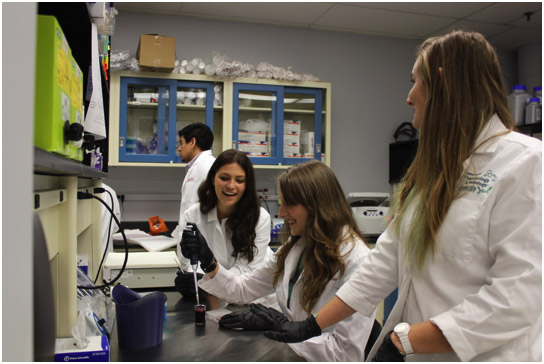
Lab members (l to r): Casey Moffitt (undergraduate), Julie Finnell (graduate student), and Calliandra Lombard (technician)
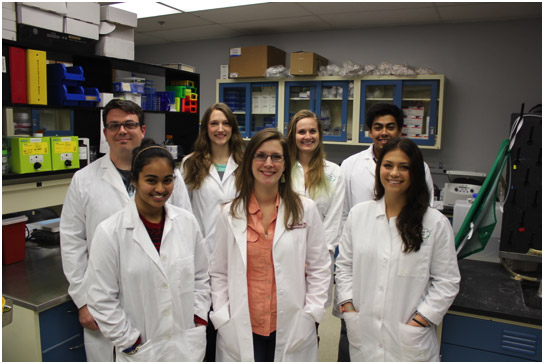
The whole lab team: Back row (l to r): Christopher Wood, PhD (Research faculty) Julie Finnell (graduate student), Calliandra Lombard (technician), Brandon Muniz (technician). Front row (l to r): Akhila Padi (undergraduate), Susan Wood, PhD (Team Leader), Casey Moffitt (Undergraduate)
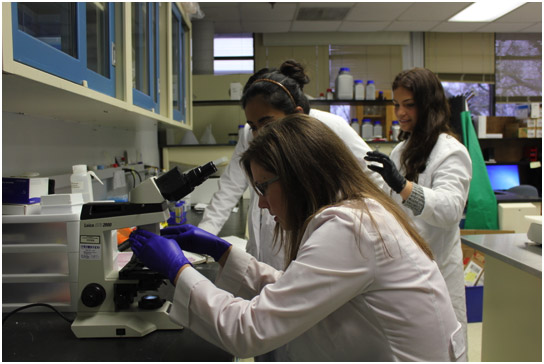
Susan Wood looking at microscope with lab members
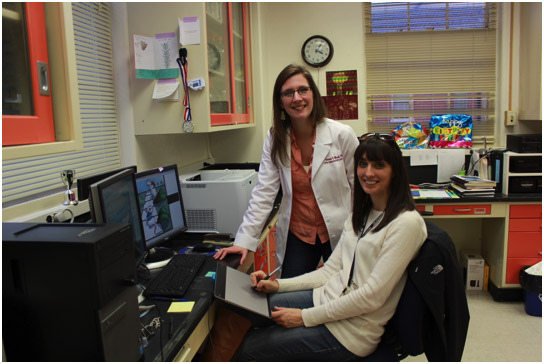
Victoria Macht (graduate student who drew the sketches for the story) and Susan Wood

Sign Up for our Monthly Announcement!
...or  subscribe to all of our stories! subscribe to all of our stories!

What A Year! is a project of the Massachusetts
Society for Medical Research.
|
|

